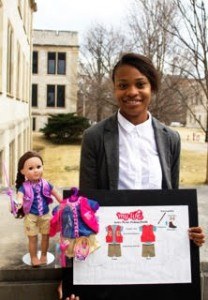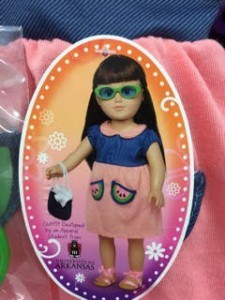The Supply Side: Walmart taps UA fashion design program for My Life doll clothes
by April 14, 2016 4:37 pm 406 views

Editor’s note: The Supply Side section of Talk Business & Politics focuses on the companies, organizations, issues and individuals engaged in providing products and services to retailers. The Supply Side is managed by Talk Business & Politics and sponsored by Propak Logistics.
––––––––––––––––
It’s not every day a college sophomore majoring in apparel merchandising creates a garment, pitches the design to Walmart, and then a few months later sees the product on a Walmart shelf.
That’s exactly what 40 students from the Apparel Merchandising and Product Development School of Human Environmental Sciences at the University of Arkansas were doing on Thursday (April 14) at the retail giant’s home office in Bentonville.
It’s the third year Walmart has worked with UA students on product designs for the retailer’s My Life doll clothes, which are sold nationwide in its retail stores. Dr. Kathy Smith, clinical associate professor in the School of Human Environmental Sciences’ apparel program, was contacted by Walmart toy buyer Haley Kochen about getting students involved in the project in 2014. Kochen graduated from the UA program in 2010.
The clothes designed by the participating UA students are featured on Walmart’s My Life doll, an 18-inch doll that wears various styles of activewear, and was created for young girls ages 8 to 12. Each outfit comes with a tag featuring the UA logo and noting that the outfit was “designed by an apparel student.” The partnership Walmart has with the UA design students makes the students service suppliers in a sense for the retail giant.

India Callahan, an apparel merchandising and product development major and one of the designers, described the experience as almost surreal. Her My Life fishing active wear garment set was selected by Walmart last year and hit stores this spring.
“It is very seldom that you find this kind of opportunity, especially at a collegiate level, where you get the chance to work with the No. 1 retailer in the world,” said Callahan. “It builds skills on a corporate level and gives you first-hand experience of how it is to work on the product development side.”
Other winning designs by last year’s class include a watermelon dress, garden clothes, hip hop dancer ensemble, red polka dot swimsuit and pink wetsuit and various dresses for multiple occasions.
“Projects such as the My Life As doll designs allow students to interact directly with professionals in the apparel industry,” Smith said. “Students can proudly build their resumes and portfolios with hands-on experiences which will set them apart from their peers as they begin their careers. Walmart and the UA have allowed our apparel students to showcase their work in a national retail arena.”
She said 2014 was the first year the sophomore class took part in the design program for My Life doll clothes. She said 24 students presented to the Walmart buyer team who was supposed to chose one design, “but they took six instead, because the designs were that good.”
The students’ spring designs were ready a full year ahead of distribution which is the typical schedule for the apparel supply chain, Smith said. The winning 2014 designs first debuted in Walmart stores last spring. She said the students spent several months researching style and color trends before creating their garments and accessories.
The students design the doll clothes using computer aided drafting software for apparel which is typically taught to sophomores. The designs are then reviewed by the Walmart team as the students make their presentations. The winning designs move to the next phase of manufacturing which is handled by one of Walmart’s garment suppliers in Vietnam.
Walmart spokeswoman Danit Marquardt said students receive class credit for the project, but no money is paid for chosen designs because it is part of their curriculum. Smith and Kochen said the experience is invaluable as it gives these students an inside look at how the fashion retail business works and it provides opportunities for them to network with professionals a full two years before they graduate.
“This is a great learning experience, understanding the cost implications of all of the design decisions that you make and designing a garment that would hit a certain cost threshold,” said Kochen, who has been with Walmart since 2010. “A lot of beautiful things I love can’t be executed because of cost, but I’m learning that you can make beautiful designs that still fit within our ‘Every Day Low Price’ model. I’m excited to be able to give back to the program that has been so good to my career. I didn’t envision doll clothing, but it’s a really fun program to develop.”
There were 24 students who presented designs to Walmart last spring and merchants chose 14 of them which hit stores earlier this year, Smith said.
“It’s great that Walmart is working with students today because they are the future of this industry. They have fresh ideas which companies can help cultivate so students can be more productive employees when they graduate. This is a fun project and we are excited to be able incorporate industry and real life perspectives in the curriculum,” Smith said.
Smith said the exercise in garment design is especially helpful in that the final product will be used by children. She said this adds another layer of scrutiny for the designers who have to be sure the products and accessories are safe and age appropriate. Smith said the students must also keep the company they are designing for in mind and use the consumer as the ultimate guiding force in the product development and retail merchandising process.

While the garment design project is typically handled by sophomores, Smith said it is not the end of the student’s outreach with the retail fashion and manufacturing industry. She said juniors and seniors learn the rest of the supply chain in creating a prototype for manufacturing and mass production and then merchandising and retail distribution is the final phase.
The seniors are preparing for a runway fashion show next Wednesday (April 20) at the Fayetteville Town Center, Smith said. Metal and Shine is the theme for this spring show where all the fashions have been designed and produced by the students in the Apparel Merchandising and Product Development School at the UA.
“We are blessed to be able to work with Walmart and other industry leaders in the apparel industry with our students and each year we see our graduates find jobs in New York, Dallas and other fashion hotspots,” Smith said. “Several of them have also landed corporate jobs at Walmart.”
The doll clothes industry is making a comeback thanks in part to the popularity of American Girl, My Life and other 18-inch dolls in recent years. Upstart Business Journals reports that many toy manufacturers pay as much as six figures which is more than the typical $60,000 to $70,000 regular fashion designers can earn. The caveat to landing a doll clothes design job is that there aren’t that many, fewer than 500, according to Coroflot, a design-job website. Mattel has about 25 garment designers for its Barbie line.
